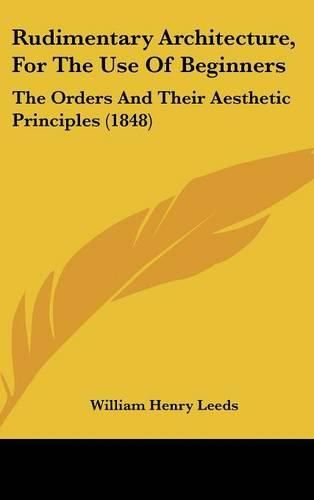Readings Newsletter
Become a Readings Member to make your shopping experience even easier.
Sign in or sign up for free!
You’re not far away from qualifying for FREE standard shipping within Australia
You’ve qualified for FREE standard shipping within Australia
The cart is loading…






Rudimentary Architecture, For The Use Of Beginners: The Orders And Their Aesthetic Principles is a book written by William Henry Leeds in 1848. The book is a comprehensive guide to the fundamental principles of architecture, specifically the classical orders and their aesthetic principles. The author provides a detailed explanation of the different orders of architecture, including the Doric, Ionic, Corinthian, and Composite orders, and their respective characteristics. The book is aimed at beginners in the field of architecture, providing a clear and concise introduction to the subject. The author uses simple language and illustrations to explain complex concepts, making it easy for readers to understand the principles of architecture. The book is divided into chapters, each covering a specific topic related to architecture. The first chapter provides an overview of the history of architecture, from ancient times to the present day. The subsequent chapters cover the different orders of architecture, including their history, characteristics, and examples of their use. The author also discusses the principles of proportion, symmetry, and harmony in architecture, and how they relate to the classical orders. Overall, Rudimentary Architecture, For The Use Of Beginners: The Orders And Their Aesthetic Principles is a valuable resource for anyone interested in learning about the fundamental principles of architecture. The book provides a solid foundation for further study and is an essential reference for architects, students, and enthusiasts alike.This scarce antiquarian book is a facsimile reprint of the old original and may contain some imperfections such as library marks and notations. Because we believe this work is culturally important, we have made it available as part of our commitment for protecting, preserving, and promoting the world's literature in affordable, high quality, modern editions, that are true to their original work.
$9.00 standard shipping within Australia
FREE standard shipping within Australia for orders over $100.00
Express & International shipping calculated at checkout
Rudimentary Architecture, For The Use Of Beginners: The Orders And Their Aesthetic Principles is a book written by William Henry Leeds in 1848. The book is a comprehensive guide to the fundamental principles of architecture, specifically the classical orders and their aesthetic principles. The author provides a detailed explanation of the different orders of architecture, including the Doric, Ionic, Corinthian, and Composite orders, and their respective characteristics. The book is aimed at beginners in the field of architecture, providing a clear and concise introduction to the subject. The author uses simple language and illustrations to explain complex concepts, making it easy for readers to understand the principles of architecture. The book is divided into chapters, each covering a specific topic related to architecture. The first chapter provides an overview of the history of architecture, from ancient times to the present day. The subsequent chapters cover the different orders of architecture, including their history, characteristics, and examples of their use. The author also discusses the principles of proportion, symmetry, and harmony in architecture, and how they relate to the classical orders. Overall, Rudimentary Architecture, For The Use Of Beginners: The Orders And Their Aesthetic Principles is a valuable resource for anyone interested in learning about the fundamental principles of architecture. The book provides a solid foundation for further study and is an essential reference for architects, students, and enthusiasts alike.This scarce antiquarian book is a facsimile reprint of the old original and may contain some imperfections such as library marks and notations. Because we believe this work is culturally important, we have made it available as part of our commitment for protecting, preserving, and promoting the world's literature in affordable, high quality, modern editions, that are true to their original work.